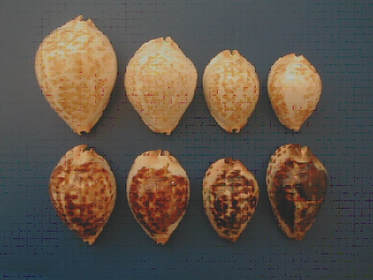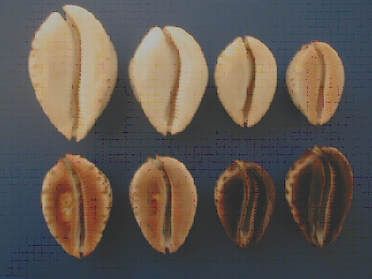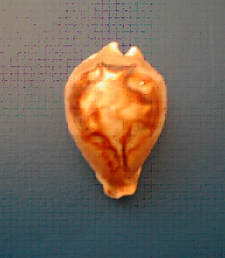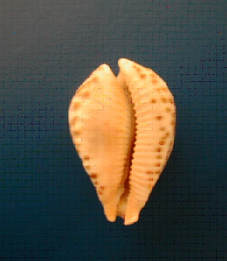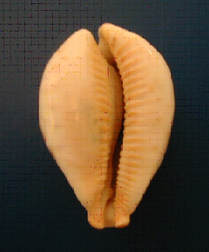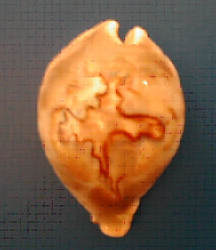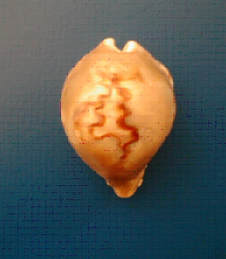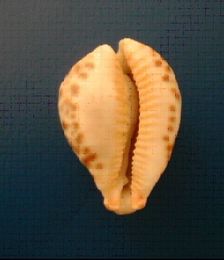The importance of naming forms and variations
by John Batt
Photography by John Batt
Photography by John Batt
For many years I have been interested in the collection of specimen shells, and for a long while now, just in the collection of the Cypraeidae and the desire to understand the immense diversity in species variation, with size, pattern, shape, colour, and differences in populations being of great interest and importance.
For me it was an exciting breakthrough when Dr Felix Lorenz and Dr Alex Hubert brought out the magnificent Guide to Worldwide Cowries. Finally collectors of this incredible family could see and understand all species, subspecies, and important named varieties, as well as view a great array of other variants set against more typical specimens – no longer do we have to rely upon dated literature written by those who seem to show very little interest in the variation within species, tend to disregard many subspecies and totally disagree with the naming of forms. However, it is important that we as specialist collectors of certain families must take into consideration intergrades between similar species or between species and subspecies and not be seen to be splitting in an unnecessary way.
Taxonomic nomenclature is just a human tool for the recognition of species and subspecies and will of course never always provide us with lasting names, as due to further findings in our world's oceans, the linking of certain species with other similar species or their subspecies will inevitably reduce many species to synonyms. So to be able to discuss these population variations and recognise them in the future we will have to use form names.
If scientists opt to ignore forms, variations and intergrades within their species and so-called subspecies we will never fully understand whether their taxonomically valid species or subspecies are truly valid or not.
Recently I have had the opportunity to thoroughly read through the fantastic World Shells publications by Dr Luigi Raybaudi Massilia, thanks to my good friend Jean Paul Van-Weert. These publications concentrate on many shell families with expert collectors the world over submitting articles, but I would like to concentrate on the approach of Raybaudi himself. As one of the world's, if not the world's most experienced and enthusiastic collectors of the Cypraeidae, Raybaudi, as is well known, always adopted form names to describe his shells and distinguish between shells from different localities, colour or pattern differences, as well as using such names as “maxima” or “minima” to describe differences in size, although I do not think that the latter is important unless you are trying to sell specimens that differ in size from a mailing list. His use of variety names worked perfectly well although he himself always maintained that these names have no taxonomic validity, but they are very helpful for ensuring that other collectors know the particular variety that you are trying to discuss, for example Zoila venusta episema “dorata” for the high-margined golden form of Z. venusta episema from Geographe Bay, a very rare and desirable form. It would surely be a great shame if collectors were unaware of its existence, as well as using the name Umbilia hesitata “capricornica” today known as a separate species although many would disagree with its scientific validity. If we do not know of these important variations through naming and discussion, how will we ever truly understand species diversity or, more importantly, name new valid species? On the other hand a new species could be named as valid only to find out at a later date that it ends up on the ever-increasing list of synonyms as the author quite unscientifically ignored or plainly knew not of any specimens intermediate between their new species and another closely related, already-named species.
Looking at this matter from a different perspective, it would be impossible to give variety names to all specimens that vary as with many species there are far too many variations, for example Cypraea tigris, Zoila venusta roseopunctata and perhaps the Volute Cymbiola aulica. So it seems that there are different levels of importance for the naming of varieties. Cypraea tigris, for example, is a very widespread species and you will find in any population many colour forms and different shaped variants, but in Hawaii you get the form “schilderiana”.
These Hawaiian shells are always much more inflated than large specimens from other localities so I think that they deserve their forma name, where as naming colour variants that appear together in a single locality is not so justified. If a certain colour form occurred in a separate locality as with the Zoila venusta episema “dorata” then I think that it is an important variation and deserving of a forma name. Even though typical episema are found close by, these golden forms with the high margins live only in this locality, their own population.
Top row: four variations of Z. jeaniana “aurata”. Specimen four is an orange-based intergrade with darker dorsal pattern.
Bottom row: four variations of Z. jeaniana. The first two specimens were trawled by Taiwanese fisherman in deep water in the late 1970s, the other two were dived in 40–50m. None is variation “sherylae".
Bottom row: four variations of Z. jeaniana. The first two specimens were trawled by Taiwanese fisherman in deep water in the late 1970s, the other two were dived in 40–50m. None is variation “sherylae".
After all is said and done, a collection of cowries containing just valid species and subspecies will only be around ten percent of a complete and thoroughly thought out collection with the most stunning, rare and desirable specimens missing, such as Barycypraea fultoni “miniatra”, Zoila thersites “eburnea”, Zoila rosselli “edingeri”, Umbilia armeniaca “brunnea”, Lyncina broderipii “somalica” and Nesiocypraea hirasei “queenslandica” to name but a few very important forms.
The case of Barycypraea fultoni
Barycypraea fultoni is a species that both Lorenz and Raybaudi had many discussions and disagreements over. Barycypraea fultoni was named as a new South African species by Sowerby III, in 1903. Since then many specimens have been trawled by Russian fishermen off Quissico, Mozambique as well as other areas further south in that country. Raybaudi originally named this northern variety as B. fultoni “mozambicana” for the shallower-water specimens that were inflated and not rhomboidal and callused in shape. He gave the name B. fultoni amorimi as a subspecies of fultoni for rhomboidal shaped shells from deeper water and used the variety name “triangularis” for extremely heavy callus triangular shaped exceptional specimens. Later Lorenz and Hubert disregarded the forma name “mozambicana” in favour of their new subspecies B. fultoni massieri, but in the second edition of their Guide admit that this move was incorrect, obviously after studying a large number of these shells and seeing how they intergrade fully into the deeper water, earlier-named subspecies B. fultoni amorimi, although they continue to use the name “massieri” at forma level only. Their mistake renders the name massieri a synonym and the name “mozambicana” the correct name to use for this variety, still at form level as Raybaudi had originally suggested.
In World Shells No. 13, p. 101, Dr Alex Hubert writes (after reading Raybaudi’s article on fultoni in World Shells No. 9, where he displays 58 specimens including intergrades running from Quissico, Mozambique to Transkei, S. Africa): “if these intergrades exist then Raybaudi’s subspecies amorimi should also be dropped along with the name 'massieri'”. Raybaudi does, however, state in World Shells No. 14, p. 90, that he no longer agrees with his own subspecies amorimi, so we now have no subspecies at all of Barycypraea fultoni, just important variations. Within Raybaudi’s article in World Shells No. 9 he introduces another important variation from Transkei, S. Africa. This is the very dark small form, by far the most sought after and rarest form of fultoni, which he names as B. fultoni “miniatra", certainly in my opinion a name that deserves to be in use.
Specimens found further north around Durban are already becoming more flanged on the margins nearing the posterior, are less dark and larger in size. Very similar shells to these Durban shells occur off Maputo in Southern Mozambique. Below is a photograph of my own specimen from Maputo. Note the more depressed, less inflated shape in comparison with the other two specimens from Quissico further north, although this Maputo specimen's teeth are not as dark as those of specimens from Durban, who’s teeth in turn are not as dark as those of specimens from Transkei.
The largest specimen pictured below centre is the northern form “mozambicana” in superb condition for this usually granulose form, and a whopping 82 mm in size. The third specimen pictured is an intergrade between “mozambicana” and the callous, heavy, squat, form from deeper water “triangularis”. Note the beginning of callosity on the margins. The following is a list of the important variations of B. fultoni that it would be necessary for collectors to obtain for a thorough collection, although many intergrades occur between these four varieties:
- Barycypraea fultoni Sowerby III, 1903 – specimens from Durban, Natal, S. Africa
- B. fultoni “miniatra” Raybaudi – Transkei, S. Africa. Dark, small, less flanged margins
- B. fultoni “mozambicana” Raybaudi – Mozambique, Quissico area. Inflated northern form
- B. fultoni “triangularis” Raybaudi – Mozambique, Quissico area. Callus margined, deeper water
This article by John Batt was first published in our magazine Pallidula in April 2006.

